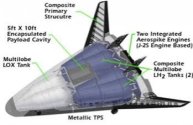CFRP is always a mess with cryogenic fuel. I would not even bother. Also, composites are way more expensive than aluminium. In infrastruture terms you need expensive tools like autoclaves. It just not worth it.Posting this here, since I find the idea of an all CFRP rocket body to be just as relevant in material science as space. They apparently use some special resin that is cryogenic resistant, liquid O2-compatible mixed together with your carbon fiber to be usable for in space environment and with the Liquid O2/methane fuel. It also uses advanced continuous fiber 3D Printing for key parts in the rocket. Again, 3D Printing specialized parts in rocket engines is really taking off. In fact, advanced material science + 3d Printing seem to be the catch phrase for rocket launchers and aerospace engines in China these days.
You are using an out of date browser. It may not display this or other websites correctly.
You should upgrade or use an alternative browser.
You should upgrade or use an alternative browser.
News on China's scientific and technological development.
- Thread starter Quickie
- Start date
CFRP is always a mess with cryogenic fuel. I would not even bother. Also, composites are way more expensive than aluminium. In infrastruture terms you need expensive tools like autoclaves. It just not worth it.
It did mention they are cryo-resistant, something to do with the resin I guess. I'm more interested in the material life time for multiple reuses, if they perform as well as aluminum alloys then it is very worthwhile, 30% weight saving.
I remember one of NASA's old proposal for SSTO (was it venture star?) involves a fully carbon fiber lifting body design with LH2/O2 fuel. They abandoned it due to the difficulty with carbon fiber fuel tank.
Also I wonder how do they do with respect to re-entry heating. Weight saving is a lot more critical for upper stage, especially for re-usable upper stage like starship. If carbon fiber can be used in this way it would be huge.
In the Venture Star even the supposedly easy LOX fuel tank never worked properly. Let alone that LH2 multi-lobed monstrosity. I meant just look at those fuel tanks.

With the Venture Star it was not just the composite fuel tanks which were a problem. It turned out the aerospike engine was much heavier than originally expected. The whole vehicle had the center of mass much further behind than expected. Which is a problem in a winged spacecraft.

With the Venture Star it was not just the composite fuel tanks which were a problem. It turned out the aerospike engine was much heavier than originally expected. The whole vehicle had the center of mass much further behind than expected. Which is a problem in a winged spacecraft.
Last edited:
In the Venture Star even the supposedly easy LOX fuel tank never worked properly. Let alone that LH2 multi-lobed monstrosity.
Yeah well tech is always evolving. Hopefully the Chinese company did crack it for real. And they're working with methane/Lox, much easier than LH2
With the Venture Star it was not just the composites fuel tanks which were a problem. It turned out the aerospike engine was much heavier than originally expected. The whole vehicle had the center of mass much further behind than expected. Which is a problem in a winged spacecraft.
I ran into the exact same issue replicating it in KSP, I ended up just enlarging the tail fins to compensate lol
In the Venture Star it is like they tried making everything as hard as possible to make the whole thing fail. A lot of people think this was accepted by NASA just to discredit the DC-X which originally came from the BMDO. NASA NIH syndrome.
Well in hindsight SSTO was never going to work in the place place, not without some magical propulsion or magical material. But enough with venture star we're off topic. Anyway I'm pretty bullish on carbon fiber, hope the company make it
How about a hybrid rocket/ramjet engine?
You will probably still need to use LH2 fuel with one.
There were designs after the 1950s with air augmented rockets like LACE.
More recently the British had Skylon.
There are also altitude compensating nozzles to further increase rocket engine performance.
There were designs after the 1950s with air augmented rockets like LACE.
More recently the British had Skylon.
There are also altitude compensating nozzles to further increase rocket engine performance.
Last edited:
